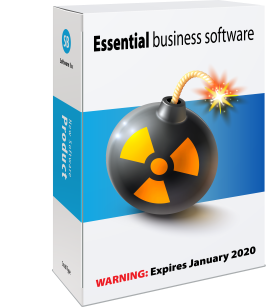The 2020 Problem
At GMA we focus our attention on people, more than we do on computers. Experience has told us people want fewer disruptions – they just want to get on with their work. Which is why we shouted about the 2020 Problem months before it happened.
Your business, like most others, relies on Microsoft software every day. It’s the software you use the most – for email, documents, to run your company’s server, and of course to run the PCs themselves. But there is a problem and very few businesses know about it!
End of Life!
Microsoft announced that a lot of its much-used software will reach “end of life” in January 2020. That doesn’t mean that it will just stop working but it does mean that it won’t be supported by Microsoft. If software breaks, or is compromised there will be no-one fixing it, it will stay broken and no new security updates will be released leaving your system vulnerable to attacks. End of life software is a target for hackers who will exploit this to get into your computer and spread malware
The following programs and technology impacted by the 2020 problem are:
- Window Server 2008 R2. Mainstream support for Windows Server 2008 R2 ended back in January 2015. The extended support ends on January 14, 2020. According to reports, customers are already experiencing hardware-related issues including a slowdown in performance and even hardware failures. It’s not optimised, and problems mount as as we go deeper into 2020.
- Small Business Server 2011
- Exchange 2010. Microsoft have announced a support extention so you can still get support and updates for this particular product untill 13th Oct 2020. We recommend moving your email to Exchange Online.
- Windows 7. If you are using Windows 7, you’re far from alone. About 40% of the world’s desktops and laptop
computers —many of them in corporate and public-sector environments—are still using Windows 7 rather than
Windows 10. - Office 2010
Security risk
You may think this is all scaremongering but consider what happened back in May 2017. That’s when hackers, using secret cyberweapons stolen from the US National Security Agency (NSA), targeted organisations like the NHS and Santander in Europe and the rest of the world with the malicious WannaCry ransomware.
The hackers used a security loophole in Windows operating systems to encrypt data on infected computers. That prevented organisations like the NHS from accessing their data. Using a tool known as ‘EternalBlue’ to speed up the spread of the ‘WannaCry’ ransomware across 150 countries. Affected organisations were issued with a ransom demand to regain access to their data, the attack hit more than a third of NHS Trusts. They were compromised because they were still using an outdated Windows system and they hadn’t followed cybersecurity recommendations, according to a National Audit Office report.
You can see from this example how vital it is to upgrade software and technology to ensure what your organisation uses is kept secure and working efficiently.
Russian Roulette
If you continue to use unsupported Microsoft software and technology after their ‘End of Life’ dates, you will be playing a deadly game of Russian roulette with your company’s future. It will only take one Trojan horse, one hack or one worm to breach your data and your company may be done. At the very least, your company’s reputation will be damaged. At the worst, your company will be penalised under the GDPR (General Data Protection Regulation) that became law on May 25, 2018.
The management of data breaches is one of the most critical aspects of the GDPR. It’s why your organisation must ensure the security of the personal data you hold on employees, customers and suppliers is adequate. The more sensitive the information you hold, the tighter the security needs to be.
If you fail to comply, you’ll not only damage your company’s reputation but also make it more likely you’ll be hit with sanctions or fines from the ICO.
That’s why using unprotected software and technology is so high-risk. It’s like leaving the keys to your office tucked under the front doormat. Or sharing your company bank details on Facebook. It’s only a matter of time until someone somewhere seizes the opportunity to take it all off your hands.
Cost implications
IT problems cost UK private sector companies a fortune every year just in terms of lost productivity. Employees in the UK’s private sector waste a whole working day every month due to IT issues, at an annual cost of £35 billion to the UK economy, according to research by IT provider Managed 24/7 and YouGov.
It found that an average of 5.59% of an employee’s productive time is wasted on IT problems. That equates to 27 minutes every day, 2.5 hours every week, or a whole day every month.
If you continue to use software and technology after their End of Life dates, you’re likely to find that they are incompatible with other software and technology, and so cause performance issues. Some applications, such as the latest version of Sage Line 50 for example, won’t install on these older versions, while others will be sluggish at best.
It’s why upgrading makes good sense. Streamlined systems mean greater productivity, so with minimal disruption to business you’ll be able to keep staff, customers and your accounts team happy.
We have produced a brief guide to the software afected and the risks here.
For a more comprehensive guide, please sign up to business news updates using the box below:
Sign up for our free IT business news updates and a copy of our 2020 problem guide
Fill in your details to receive our free IT business news updates access, access to other content such as white papers and webinars and to get your guide sent to you.
